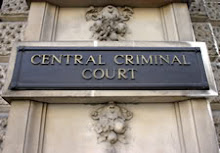Old Bailey Sessions House, January 1715.
52 indictments were heard , of which 5 were multiple indictments.
57 persons were actually on trial : 25 were acquitted.
32 guilty verdicts : 1 was sentenced to stand in a pillory , 8 were to be whipped , 17 were to be branded on the hand and 6 were to be hanged.
The trials lasted for 3 days with the court sitting from 6.30 am until 9pm.
The Old Bailey Sessions House was off , rather than on, a busy thoroughfare connecting Newgate Street and Ludgate Street. Its complex spaces of courtyards, outbuildings and the Sessions House itself, which is described as “a three-storey, Italianate structure” completed in 1673 after the Great Fire of London in 1666, that could only be approached by a single alleyway.
Having entered this alley, 3 different spaces would appear to the viewer.
First , a large gathering place known as the Sessions House Yard , where all the witnesses, court attendants, turnkeys, prosecutors, defenders, jurors, judges and the accused would sort themselves out.
A bail-dock, which was a low wall with short spikes affixed to the top, marked a division between the Sessions House Yard and the second space.
After 1714, when a turnkey had been murdered, prisoners were kept chained and shackled near this dock where they were exposed to the elements. After 1716, following a justly convicted highwayman vaulted the dock and escaped into the crowd, iron bars were installed.
On the otherside of this dock was a plain Doric portico whose netherside was completely open ( except for four rows of supporting columns ) to the ground floor of the Sessions House.
Stone steps, railings and a balustrade provided entryways on either side of the portico. Within, elevated several feet above the yard covered by the upper part of the House, was the Judges’ bench. On either side were partitions enclosing the jurors and above these were small balconies for court officers and well-placed observers.
The scene has been described as a “ giant Punch and Judy show “ or “ the amphitheatre of a Greek tragedy “.
Presiding over all this was the Lord Mayor , Sir William Humphreys; baron of the Exchequer , Robert Tracy; the King’s Bench judge , John Pratt; Lord Chief Baron of the Exchequer, Samuel Dodd; Chief Justice of Common Pleas & Recorder of London, Peter King.
Flanking the Bench, between it and the defendants were the jurors. They were not “peers”
Of the defendants as they were landowners, small landowners admittedly, but still of the landed-gentry class.
In January 1715 , these jurors found 32 people guilty of the indictments. Of these 29 were crimes against property but did noy involve the theft of money.
Some made a trade of being a juryman seeking office or favours by refusing to give a “ disobliging” verdict. Others were motivated by the “ humour of revenge “. They rendered verdicts based upon the size of estates or to avoid the trouble of disputing the point or to “ prevent the spoiling of dinner by delay “.
Standing jurors , those who actively sought to become jurors or to remain in the jury pool for several cases were favoured in Voir Dire ( see below ) proceedings by prosecutors and distrusted by the defence. It had been shown that their willingness to sit in judgement tended to give a larger number of guilty verdicts than those who accepted the responsibility only with reluctance.
One of the reasons why jurors were supposed to be selected “ by lot “ ( BLACKSTONE ) was to avoid the presence of those who actually liked the job. Another reason was to prevent great familiarity with the judges.
The moral character of jurors is suggested by Bunyan’s allegorical account of a trial presided over by “ Lord Hategood “. In his summation to the jury, he cited as legal authority Pharaoh, Nebuchadnezzar and Darius, who were accepted by a jury consisting of Mr.Blind Man ; Mr.No-good ; Mr.Malice ; Mr.Love-lust ; Mr.Live-loose ; Mr.Heady ; Mr.High Mind ; Mr.Emnity ; Mr.Lyar ; Mr.Cruelty ; Mr.Hate-light and Mr.Implacable.
The third space of the Old Bailey Sessions House was filled with people who were spectators with a “ hearing and determination” of their own ( oyer and terminer ).
voir dire [ vwaar deer ] |
noun |
Definition: |
competence examination of witness or juror: the preliminary examination of a witness or juror to determine his or her competence to give or hear evidence. |
[Late 17th century. < Law French< Old French voir 'truth' + dire 'speak'] |

No comments:
Post a Comment